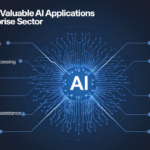AI Data Center Project: A Paradigm Shift in Data Management and Processing
Project Overview:
The AI Data Center project represents a significant leap in the management, processing, and utilization of data. As the demand for AI and machine learning applications grows exponentially, traditional data centers are being transformed into AI-driven powerhouses that can handle vast amounts of data with unprecedented efficiency. This project aims to integrate cutting-edge technologies such as AI, machine learning (ML), and blockchain to create a state-of-the-art data center capable of supporting the next generation of AI applications.
Objectives:
1. Enhanced Data Processing Capabilities:
– Implement AI and ML algorithms to optimize data processing, ensuring faster and more accurate analysis.
– Utilize edge computing to process data closer to its source, reducing latency and bandwidth usage.
2. Scalability and Flexibility:
– Design a modular architecture that allows for easy scalability to meet growing data demands.
– Incorporate cloud-based solutions to provide flexible storage and computing resources.
3. Energy Efficiency and Sustainability:
– Develop energy-efficient cooling systems and power management solutions.
– Integrate renewable energy sources to minimize the environmental impact of the data center.
4. Security and Data Integrity:
– Employ blockchain technology to ensure data integrity and security.
– Implement robust cybersecurity measures to protect against data breaches and cyber-attacks.
5. **Automated Operations and Maintenance:**
– Use AI-driven predictive maintenance to foresee and mitigate potential hardware failures.
– Automate routine operations to reduce human intervention and operational costs.
Key Components:
1. AI and ML Integration:
Data Processing: Advanced AI algorithms will handle data preprocessing, cleaning, and analysis. This will significantly speed up data processing times and enhance the accuracy of AI models.
Predictive Analytics:** Machine learning models will predict future data loads and optimize resource allocation, ensuring smooth operations during peak times.
2. Edge Computing:
Proximity Processing:** Data will be processed at the edge of the network, close to the data source, reducing latency and improving real-time data analytics capabilities.
Bandwidth Optimization: By processing data locally, edge computing will reduce the amount of data that needs to be transmitted to central servers, optimizing bandwidth usage.
3. Blockchain for Security:
Immutable Ledger: All data transactions and changes will be recorded on an immutable blockchain ledger, ensuring transparency and preventing tampering.
Smart Contracts: Automated smart contracts will manage data access and permissions, enhancing security and compliance.
4. Energy Efficiency:
Green Energy: The data center will leverage renewable energy sources such as solar and wind to power its operations.
Cooling Systems: Advanced cooling technologies, including liquid cooling and AI-optimized HVAC systems, will be used to reduce energy consumption.
5. Automated Operations:
AI-Powered Maintenance: Predictive maintenance systems will use AI to analyze equipment performance and predict failures before they occur, reducing downtime.
Operational Automation: Routine tasks, such as software updates and system monitoring, will be automated using AI, freeing up human resources for more strategic activities.
Implementation Phases:
Phase 1: Planning and Design
– Conduct a comprehensive needs assessment to define the project scope and objectives.
– Design the data center architecture, focusing on modularity, scalability, and integration of AI, ML, and blockchain technologies.
Phase 2: Infrastructure Development
– Construct the physical infrastructure, including data center buildings and power systems.
– Install advanced cooling systems and renewable energy sources.
Phase 3: Technology Integration
– Deploy AI and ML algorithms for data processing and predictive maintenance.
– Implement blockchain technology for data security and integrity.
– Set up edge computing nodes to handle local data processing.
Phase 4: Testing and Optimization
– Conduct thorough testing of all systems to ensure they meet performance and security standards.
– Optimize AI algorithms and edge computing setups to maximize efficiency.
Phase 5: Deployment and Monitoring
– Launch the AI data center and begin full-scale operations.
– Continuously monitor performance and make adjustments as necessary to ensure optimal operation.
Expected Outcomes:
Increased Efficiency: Faster data processing and reduced latency will enhance the performance of AI applications.
Scalability: The modular design will allow the data center to scale effortlessly to meet growing data demands.
Sustainability: Energy-efficient systems and renewable energy sources will reduce the environmental impact.
Security: Blockchain and advanced cybersecurity measures will ensure data integrity and protect against cyber threats.
Cost Savings: Automated operations and predictive maintenance will reduce operational costs and downtime.
The AI Data Center project represents a forward-thinking approach to data management, combining the power of AI, ML, and blockchain to create a robust, efficient, and secure data center. This project not only addresses current data processing challenges but also sets the stage for future advancements in AI and data science, paving the way for innovative applications and services across various industries.









